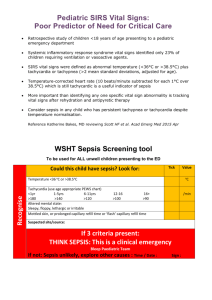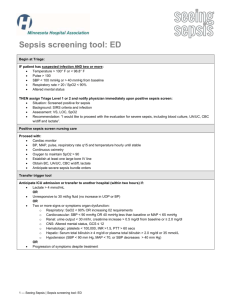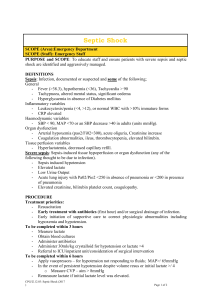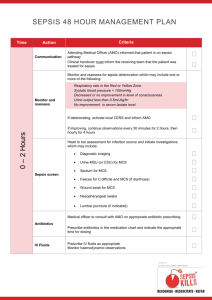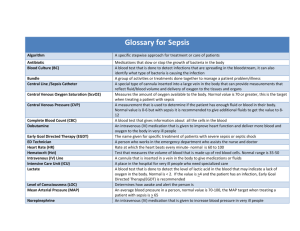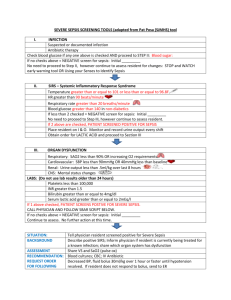Q1. What Is sepsis?
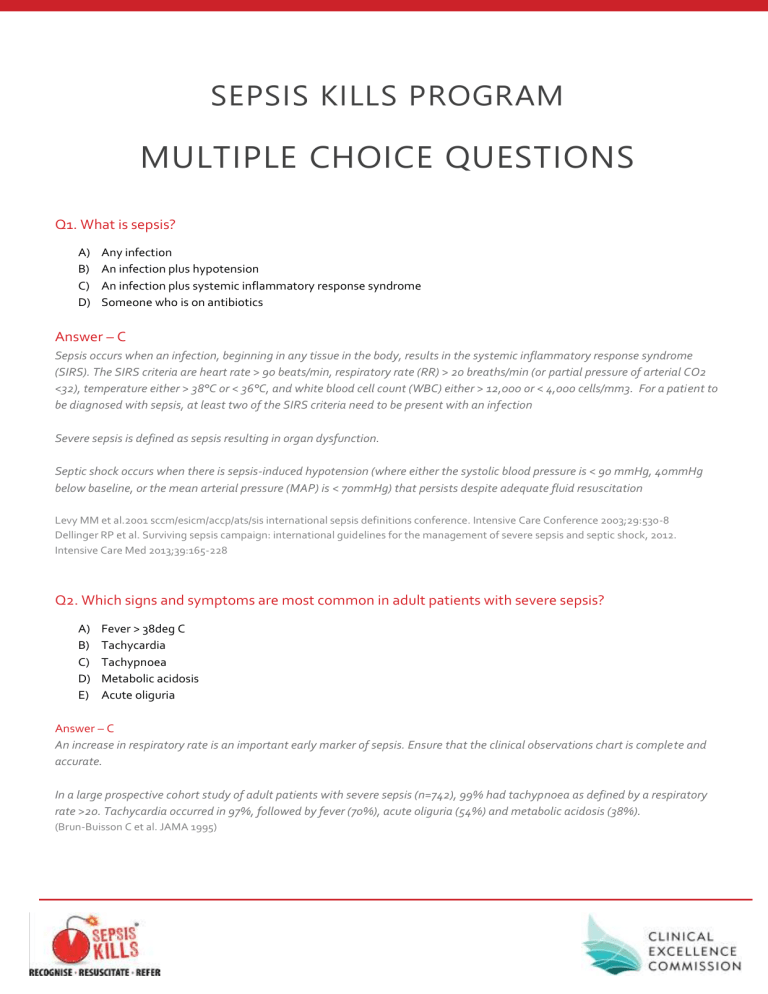
SEPSIS KILLS PROGRAM
MULTIPLE CHOICE QUESTIONS
Q1. What is sepsis?
A) Any infection
B) An infection plus hypotension
C) An infection plus systemic inflammatory response syndrome
D) Someone who is on antibiotics
Answer – C
Sepsis occurs when an infection, beginning in any tissue in the body, results in the systemic inflammatory response syndrome
(SIRS). The SIRS criteria are heart rate > 90 beats/min, respiratory rate (RR) > 20 breaths/min (or partial pressure of arterial CO2
<32), temperature either > 38°C or < 36°C, and white blood cell count (WBC) either > 12,000 or < 4,000 cells/mm3. For a patient to be diagnosed with sepsis, at least two of the SIRS criteria need to be present with an infection
Severe sepsis is defined as sepsis resulting in organ dysfunction.
Septic shock occurs when there is sepsis-induced hypotension (where either the systolic blood pressure is < 90 mmHg, 40mmHg below baseline, or the mean arterial pressure (MAP) is < 70mmHg) that persists despite adequate fluid resuscitation
Levy MM et al.2001 sccm/esicm/accp/ats/sis international sepsis definitions conference. Intensive Care Conference 2003;29:530-8
Dellinger RP et al. Surviving sepsis campaign: international guidelines for the management of severe sepsis and septic shock, 2012.
Intensive Care Med 2013;39:165-228
Q2. Which signs and symptoms are most common in adult patients with severe sepsis?
A) Fever > 38deg C
B) Tachycardia
C) Tachypnoea
D) Metabolic acidosis
E) Acute oliguria
Answer – C
An increase in respiratory rate is an important early marker of sepsis. Ensure that the clinical observations chart is complete and accurate.
In a large prospective cohort study of adult patients with severe sepsis (n=742), 99% had tachypnoea as defined by a respiratory rate >20. Tachycardia occurred in 97%, followed by fever (70%), acute oliguria (54%) and metabolic acidosis (38%).
(Brun-Buisson C et al. JAMA 1995)
Q3. Which of the following criteria present and new in your patient should prompt commencement of the Sepsis Pathway?
A) RR - 20 breaths/min
B) RR - 20 breaths/min + HR > 122bpm
C) RR > 25 breaths/min + HR > 120bpm + recent surgery
Answer - C
In NSW any one risk factor, sign or symptom plus 2 Yellow Zone observations or 1 Red Zone observation should prompt obtaining senior clinician review or a Rapid Response call and the consideration of the commencement of the Sepsis Pathway. Sepsis is a medical emergency
Q4. Patients with severe sepsis and a lactate level ≥ 4 mmol/L have an increased likelihood of mortality compared to patients with a normal lactate.
A) True
B) False
Answer - True
Lactate is a normal product of anaerobic cell metabolism and is released into the blood and metabolised by the liver. Normal lactate levels are less than 1.0 mmol/L in both arterial and venous blood. Elevated serum lactate is strongly associated with morbidity and mortality in critically ill patients. One study showed a level above 4.0 mmol/L was associated with a 27% mortality rate compared with 7% for patients with a lactate of 2.5-4.0mmol/L
(Boschert S. Is it Septic Shock? Check Lactate Level ACEP News 2007)
Elevated lactate is typically present in patients with severe sepsis or septic shock and can occur even before patients have a marked acidosis or low blood pressure. Cryptic shock is defined as a serum lactate greater than 4 mmol/L and normotensive.
It is therefore important to screen for serum lactate in all patients who are suspected of sepsis irrespective of a normal blood pressure.
Elevated lactate is a late sign of sepsis in children. Where lactate is greater than 2mmol/L and sepsis is suspected, it is recommended that immediate treatment is started.
Q5. In patients with sepsis, which of the following statements is incorrect?
A) Antibiotics should never be delayed while waiting for the results of investigations.
B) Patients with febrile neutropenia should be managed using the local febrile neutropenia guideline
C) Time to first dose antibiotics does not influence outcome
D) The patient should be reviewed by the attending medical officer within 24 hours of starting on sepsis pathway and antibiotic therapy, with referral to the infectious diseases / clinical microbiology service for specific advice.
Answer - C
Intravenous antibiotic therapy should be started immediately after obtaining appropriate cultures, since early initiation of antibiotic therapy is associated with lower mortality. The choice of antibiotics should also be guided by the patient's history including recent antibiotic exposure, comorbidities, clinical context (eg, community- or hospital-acquired infection), Gram-stain data and previous resistant bacterial isolates.
Poor outcomes are associated with inadequate or inappropriate antibiotic selection as well as delays in starting antibiotic therapy.
A retrospective cohort study of 2,154 patients with septic shock found that each hour of delay in antibiotic administration over the first 6 hours was associated with an average decrease in survival of 7.6%. Therefore statement C is INCORRECT, time to first dose antibiotics DOES significantly influence outcome.
(Kumar A, Crit Care Med. 2006)
Q6. Which signs and symptoms are most common in children and infants with sepsis?
A) Fever >38deg C
B) Persistent Tachycardia
C) Lethargy
D) Metabolic acidosis
E) Lactate >4mmol/L
Answer - B
Persistent tachycardia is a reliable sign in the early recognition of sepsis in children and infants. More specifically persistent tachycardia that is resistant to treatment such as fluid bolus or antipyretics.
Not all children with sepsis will have a fever and administering antipyretics pre hospital can mask a high temperature particularly at triage and is therefore not a reliable sign or symptom of sepsis. Children can often compensate very well and relying solely on a patient’s pH again is not a reliable indicator of sepsis in children. Children and infants do not always respond to sepsis in the same way that adults do regarding an elevated lactate. It is therefore important to have a heightened level of concern with a lactate over 2mmol/L with this group.
Q7. During the monitor and reassess phase of resuscitation of the septic child or infant, which of the following signs of deterioration indicates your patient requires escalation in level of care?
A) Persistent tachycardia, slow capillary refill and hypotension
B) Drowsiness or abnormal LOC and /or urine output<1ml/kg/hr
C) Acidosis, increasing serum lactate or procalcitonin
D) Hypoglycaemia, leukopenia or abnormal coagulation
E) Any of the above
Answer - E
These are all signs suggesting your patient has severe sepsis or septic shock and has not adequately responded to treatment. This patient will require escalation in level of care and may need transfer to a paediatric Intensive Care Unit.
Q8. BP is a reliable parameter in the early recognition of sepsis in paediatric patients
A) True
B) False
Answer- False
Children are able to maintain their BP despite significant compromise. They can prevent a reduction in their BP by vasoconstriction and increasing their heart rate. Neonates unlike adults cannot change their stroke volume so they increase their heart rate to improve cardiac output. This persistent tachycardia is a valuable sign in identifying sepsis.
Q9. Fluid resuscitation in paediatric sepsis should be given as:
A) 10ml/kg 0.9% sodium chloride over 20minutes
B) 20ml/kg bolus of 0.9% sodium chloride over no more than 10minutes
C) 20ml/kg bolus of 0.9% sodium chloride over 60 minutes
D) 10ml/kg 0.9% sodium chloride over 10minutes
Answer - B
Fluid resuscitation should be given as a push of 20ml/kg 0.9% sodium chloride over no more than 10 minutes .
Q10. Key messages are: SEPSIS KILLS & TIME IS LIFE. Fill in the boxes: risk factors, signs, symptoms of sepsis and have early involvement of senior clinicians with rapid IV fluids (20ml/kg 0.9% sodium chloride) and administer antibiotics within one hour
to appropriate in hospital teams or retrieval
Answer
RECOGNISE
RESUSCITATE,
REFER
